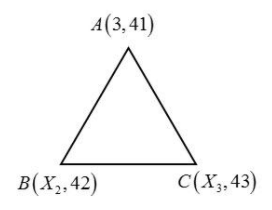
In triangle ABC vertices are $A\left( {3,41} \right)$, $B\left( {{X_2},42} \right)$ and $C\left( {{X_3},43} \right)$, then find the area.
Answer
561.3k+ views
- Hint: Generally in these type of question or we say for finding the area of triangle whose vertices is given we can use the formula i.e.
For vertices $A\left( {3,41} \right)$, $B\left( {{X_2},42} \right)$ and $C\left( {{X_3},43} \right)$, the area of triangle ABC is given by:
$\dfrac{1}{2}\left[ {{X_1}\left( {{Y_2} - {Y_3}} \right) + {X_2}\left( {{Y_3} - {Y_1}} \right) + {X_3}\left( {{Y_1} - {Y_2}} \right)} \right]$
If you cannot remember this formula then you can generate this formula by using determinant. For example: area of triangle with vertices $A\left( {{X_1},{Y_1}} \right),B\left( {{X_2},{Y_2}} \right),C\left( {{X_3},{Y_3}} \right)$ is
$\dfrac{1}{2}\left( {\begin{array}{*{20}{c}}
{{X_1}}&{{Y_1}}&1 \\
{{X_2}}&{{Y_2}}&1 \\
{{X_3}}&{{Y_3}}&1
\end{array}} \right)$
We can easily find the area of any triangle whose vertices will be given by using this formula.
Complete step-by-step solution:
Let $\vartriangle ABC$ is

Vertices of triangle ABC is $A\left( {3,41} \right)$, $B\left( {{X_2},42} \right)$and $C\left( {{X_3},43} \right)$
Now, area of $\vartriangle ABC$= $\dfrac{1}{2}\left[ {{X_1}\left( {{Y_2} - {Y_3}} \right) + {X_2}\left( {{Y_3} - {Y_1}} \right) + {X_3}\left( {{Y_1} - {Y_2}} \right)} \right]$
Here,
${X_1} = 3$, ${Y_1} = 41$
${X_2} = {X_2}$, ${Y_2} = 42$
${X_3} = {X_3}$, ${Y_3} = 43$
Putting values,
Area of $\vartriangle ABC$= $\dfrac{1}{2}\left[ {3\left( {42 - 43} \right) + {X_2}\left( {43 - 41} \right) + {X_3}\left( {41 - 42} \right)} \right]$
$ = \dfrac{1}{2}\left[ {3\left( { - 1} \right) + {X_2}\left( 2 \right) + {X_3}\left( { - 1} \right)} \right]$
$ = \dfrac{1}{2}\left( { - 3 + 2{X_2} - {X_3}} \right)$ Square units.
$ = \dfrac{{ - 1}}{2}\left( {3 - 2{X_2} + {X_3}} \right)$Square units.
Note:
Make the calculation carefully so that you should not make any mistake. One can make a mistake while putting values of points in the formula used. So be careful while putting values. In any triangle if vertices are given of that triangle then we can find the area of that triangle easily by using this formula.
For vertices $A\left( {3,41} \right)$, $B\left( {{X_2},42} \right)$ and $C\left( {{X_3},43} \right)$, the area of triangle ABC is given by:
$\dfrac{1}{2}\left[ {{X_1}\left( {{Y_2} - {Y_3}} \right) + {X_2}\left( {{Y_3} - {Y_1}} \right) + {X_3}\left( {{Y_1} - {Y_2}} \right)} \right]$
If you cannot remember this formula then you can generate this formula by using determinant. For example: area of triangle with vertices $A\left( {{X_1},{Y_1}} \right),B\left( {{X_2},{Y_2}} \right),C\left( {{X_3},{Y_3}} \right)$ is
$\dfrac{1}{2}\left( {\begin{array}{*{20}{c}}
{{X_1}}&{{Y_1}}&1 \\
{{X_2}}&{{Y_2}}&1 \\
{{X_3}}&{{Y_3}}&1
\end{array}} \right)$
We can easily find the area of any triangle whose vertices will be given by using this formula.
Complete step-by-step solution:
Let $\vartriangle ABC$ is

Vertices of triangle ABC is $A\left( {3,41} \right)$, $B\left( {{X_2},42} \right)$and $C\left( {{X_3},43} \right)$
Now, area of $\vartriangle ABC$= $\dfrac{1}{2}\left[ {{X_1}\left( {{Y_2} - {Y_3}} \right) + {X_2}\left( {{Y_3} - {Y_1}} \right) + {X_3}\left( {{Y_1} - {Y_2}} \right)} \right]$
Here,
${X_1} = 3$, ${Y_1} = 41$
${X_2} = {X_2}$, ${Y_2} = 42$
${X_3} = {X_3}$, ${Y_3} = 43$
Putting values,
Area of $\vartriangle ABC$= $\dfrac{1}{2}\left[ {3\left( {42 - 43} \right) + {X_2}\left( {43 - 41} \right) + {X_3}\left( {41 - 42} \right)} \right]$
$ = \dfrac{1}{2}\left[ {3\left( { - 1} \right) + {X_2}\left( 2 \right) + {X_3}\left( { - 1} \right)} \right]$
$ = \dfrac{1}{2}\left( { - 3 + 2{X_2} - {X_3}} \right)$ Square units.
$ = \dfrac{{ - 1}}{2}\left( {3 - 2{X_2} + {X_3}} \right)$Square units.
Note:
Make the calculation carefully so that you should not make any mistake. One can make a mistake while putting values of points in the formula used. So be careful while putting values. In any triangle if vertices are given of that triangle then we can find the area of that triangle easily by using this formula.
Recently Updated Pages
How do you convert r6sec theta into Cartesian form class 10 maths CBSE

How do you solve dfrac5y3dfracy+72y6+1 and find any class 10 maths CBSE

If sin A+B1 and cos AB1 0circ le left A+B rightle 90circ class 10 maths CBSE

On the number line 10 is to the of zero class 10 maths CBSE

How do you solve 5xge 30 class 10 maths CBSE

In the following sentence supply a verb in agreement class 10 english CBSE

Trending doubts
Write an application to the principal requesting five class 10 english CBSE

Why is there a time difference of about 5 hours between class 10 social science CBSE

List of Lok Sabha Speakers of India

Which one of the following is the deepest seaport of class 10 social science CBSE

Write a letter to the principal requesting him to grant class 10 english CBSE

The Equation xxx + 2 is Satisfied when x is Equal to Class 10 Maths




